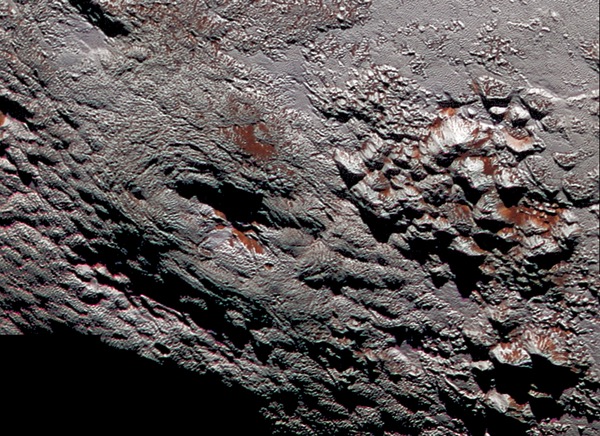
Life on Plutoby Dwayne Day
|
| Way out there on the deep dark edges of our solar system, Pluto has been an enigmatic subject of fiction, showing up rarely in science fiction stories. |
Okay, yeah, actually, according to the girlfriend, he said life on Mars. But when she wrote this down in her diary she wrote “NASA found life on Pluto,” and was too tired to correct it. (Who knows? Alcohol might have been involved too; it was apparently a wild night.) We found this out after she (shockingly) sold her story to the Star, and that’s how the rumors of the possibility of evidence of life on a Martian meteorite first leaked out.
We now know that the meteorite did not indicate that there was life on Mars, but scientists still keep looking. As for Pluto, well, we now know a lot more about Pluto, but nobody is talking about signs of life on Pluto. Yet. But maybe that will change.
Way out there on the deep dark edges of our solar system, Pluto has been an enigmatic subject of fiction, showing up rarely in science fiction stories. So little has been known about Pluto that writers simply haven’t been able to take advantage of it as a story setting. Although Wikipedia has entries for fiction about all of the planets, including a “Pluto in fiction” entry, it is, unsurprisingly, rather short.
Pluto served as an alien base in the 1974 Japanese anime series Space Battleship Yamato. It was the location from which the evil Gamilons launched their “planet bombs” at Earth. Pluto also appeared in a number of Robert Heinlein stories in the 1950s, although usually only making a cameo. In the late, deeply-lamented animated show Futurama, Pluto was a penguin sanctuary. The 1999 computer animated series Roughnecks: Starship Troopers Chronicles set several episodes on Pluto where soldiers battle an alien invasion, which was about the most extensive fictional treatment that the little world has received.
Larry Niven came up with probably one of the most clever ideas involving Pluto in his 1968 short story “Wait It Out.” A stranded astronaut is on the surface of Pluto where he has frozen solid. But at the supercold temperatures far out in space his body has essentially become a superconductor that is active by night and deactivated by the faint energy of the Sun: he comes alive and “thinks,” albeit very slowly, whenever the tiny distant Sun is missing from the sky; before staring contemplatively at the darkness. There he stands, perhaps forever, waiting for a rescue that may never come.
Of course, Mars has been the planet (other than Earth) that has been the focus of the most fiction—good, bad, awful, lame. Edgar Rice Burroughs set his rollicking John Carter fantasies on Mars. But the author who treated the red planet with the most sense of realism and respect and sense of place was Kim Stanley Robinson, whose Red Mars trilogy was announced as a new television show for Spike TV but now appears to be on hold, meaning that it may never happen. Now that we know a lot more about Pluto, an imaginative author could use its actual terrain much more effectively for storytelling, perhaps with astronauts trekking across Sputnik Planum, or climbing Norgay Montes, or rappelling down into the crevasses of Tombaugh Regio.
 A New Horizons image of Wright Mons, a potential cryovolcano on Pluto. (credit: NASA/JHUAPL/SwRI) |
Pluto has almost always served as an alien or human base of operations, not a location for indigenous life. It’s not hard to see why—how would life form on a planet so incredibly cold? Niven’s short story offers one option, with electricity enabling consciousness, but maybe there are others. The data that keeps coming back from NASA’s New Horizons mission concerning Pluto is fascinating. Even if you know very little about planets and moons, the obvious thing you see when looking at Pluto’s surface is the lack of craters. There are remarkably few craters, indicating that the surface is very young, with most of the craters filled in with stuff. Flowing stuff. There is energy and movement, albeit on geologic scales, but Pluto is far more complicated than anybody imagined.
| But it is life here that imagines life out there, and New Horizons has provided the fuel for new imagination. |
Last year, before the Pluto encounter, I wrote about how we were in the “before flyby” phase and soon would be in the “after flyby” phase and this would inevitably affect art and culture in predictable and unpredictable ways (see “Deep in space, corner of No and Where,” The Space Review, June 15, 2015). The predictable change was that before the New Horizons flyby, most articles about Pluto were illustrated with an artist’s impression of Pluto, and after the flyby articles are almost always illustrated with actual photos of the planet—before/after, fiction/reality.
But how will all this new data about Pluto affect our fiction? Will the reality also change our fiction? When Pluto was entirely mysterious, nothing more than a tiny dot in photographs, authors had to use their imaginations to depict the planet and usually their imaginations were rather weak about Pluto: cold, dark, mostly just a place for a tiny bit of action to occur in a much bigger story.
But perhaps now there are diligent scribes staring at images of the ice mountains and the evidence of past nitrogen lakes and rivers and cryovolcanoes and haze and clouds (clouds?!) and all this wonderful crazy weirdness. And maybe they are dreaming up some bizarre alien life form that has evolved on Pluto and astronauts landing on the surface, as many miles away something crawls to the surface of a dark Plutonian loch. Maybe it is friendly. Or maybe not. But it is life here that imagines life out there, and New Horizons has provided the fuel for new imagination.